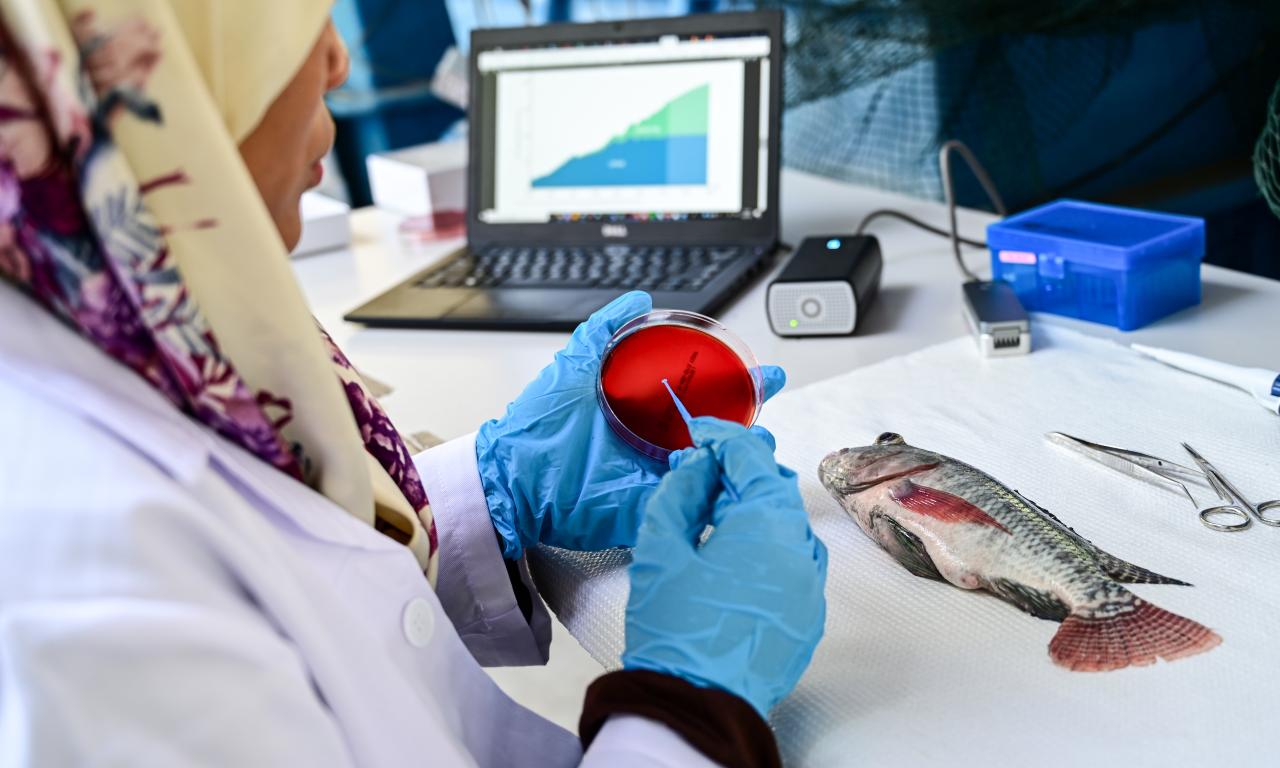
According to the latest data, almost half of the world’s fish, shellfish and other aquatic foods are farmed rather than caught, and this is forecast to grow in the years ahead.
Managing health of farmed fish is, therefore, increasingly important as disease outbreaks on fish farms reduce productivity and profitability. Globally, disease-related losses in the aquaculture sector were estimated to exceed USD 6 billion in 2017.
Aquatic animal diseases not only undermine food and nutrition security by reducing supply, but they can also cause foodborne illness in people. This warrants the need for a One Health approach, which treats the health of animals, people and environment as interconnected.
To date, investments into developing diagnostic technologies to help manage the health of aquatic animals have disproportionately focused on globally high-value species such as shrimp and salmon.
At WorldFish, we harness advances in aquatic biosciences to reduce the cost and losses of disease outbreaks to small-scale fishers, who typically rely on lower value and indigenous species, such as carp, catfish and tilapia.
Cracking the Genetic Code of Fish Pathogens
Using new diagnostic tools, we have been able to genetically characterize common disease-causing pathogens that limit aquaculture production in developing countries. This allows for more targeted treatments to prevent or reduce the spread of disease and, therefore, control financial loss.
For example, in 2023 our team sequenced for the first time the complete genome of several tilapia lake virus (TiLV) samples using nanopore technology. TiLV can cause up to 90 percent mortality in affected farms, jeopardizing the present global production of more than 6 million metric tons of tilapia annually. The disease has been reported in more than 18 countries, including Bangladesh, Colombia, India and the Philippines.
Nanopore sequencing is a simple, accurate, inexpensive and portable system that uses flow cells containing tiny holes or nanopores to measure electric current, which is then decoded to determine the DNA or RNA sequence in real time.
With the complete genomes of viruses isolated from a range of locations, we are better able to understand the genetic variations of the virus, track the emergence of new strains and develop custom vaccines that protect fish from specific disease threats. All of this helps increase the ability to protect tilapia and reduce the economic cost of TiLV to fish farmers.
Protecting Animal and Human Health
We also used nanopore sequencing to track drug-resistant strains of E. coli and Salmonella in tilapia and shrimp products in wet markets in Bangladesh. These zoonotic pathogens pose a significant risk to human health with growing levels of drug resistance making the diseases they cause increasingly untreatable. Findings on the level and nature of antimicrobial resistant bacteria found in fish and seafood sold in wet markets indicated a need for better hygiene measures within food markets and along the value chain.
Rapid Diagnostics for Healthier Fish and Fisheries
We further leveraged the portability and cost-efficacy of nanopore technology to develop monitoring and diagnostic tools for specific strains of aquatic pathogens. For example, Lab in a Backpack equips specialist end-users with simple and remote methods for sampling, processing, sequencing and quickly identifying disease-causing agents affecting their fishstock. The tool accelerates the ability to treat fish more effectively, develop vaccines and prevent outbreaks from spreading through better biosecurity.
Scaling out the Lab in a Backpack tool can empower developing countries to prevent and manage common disease outbreaks, which means more, healthier fish reaching the market and a better return for small-scale farmers. Rapid and accurate diagnostic data can also inform policymakers, health agencies and industry about emerging food safety issues and encourage investment in improved sanitation practices along the entire value chain.
In 2023, we also worked to build national capacities for managing aquatic animal diseases by introducing nanopore sequencing technology to aquaculture researchers from five different countries through a 6-day training program.




